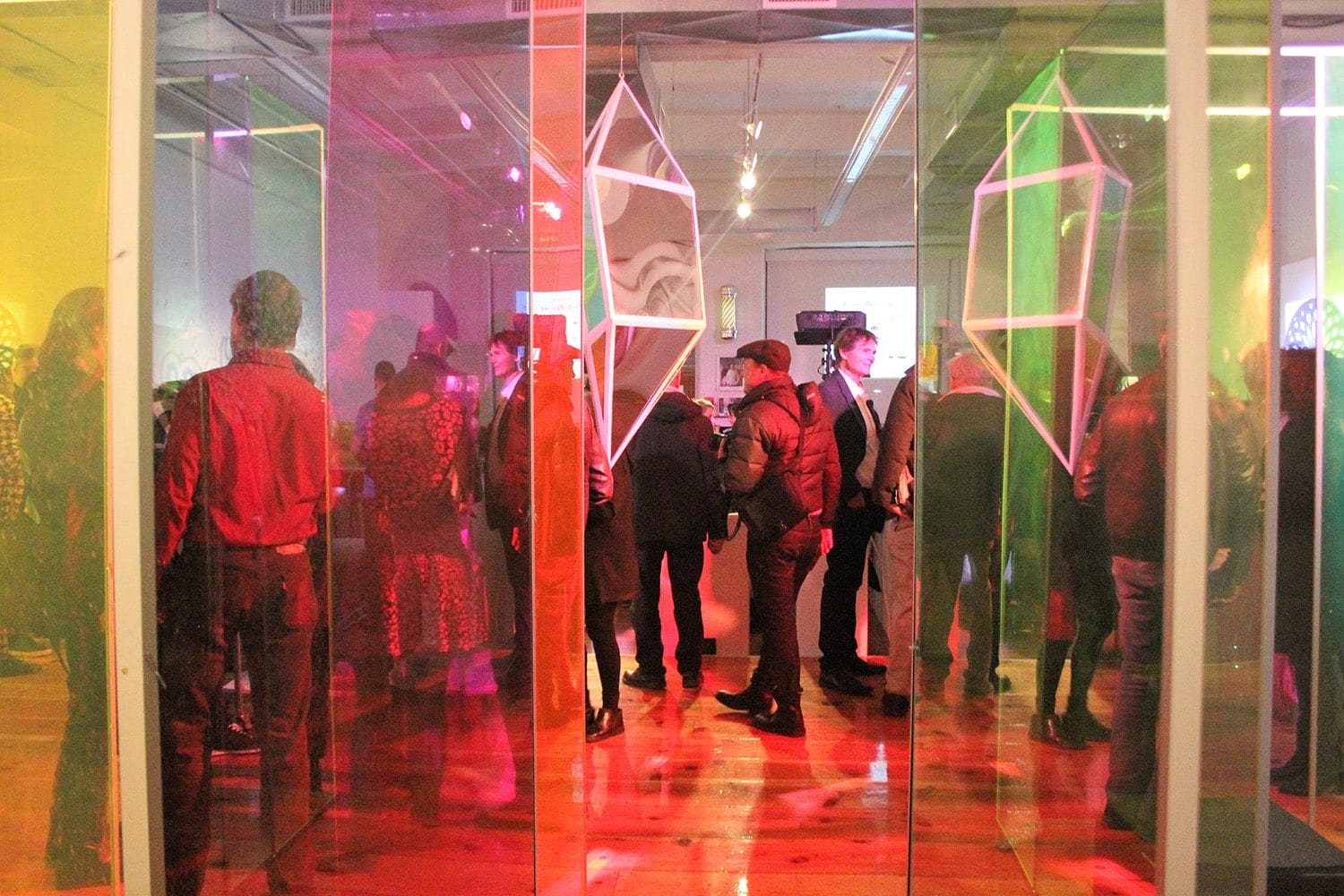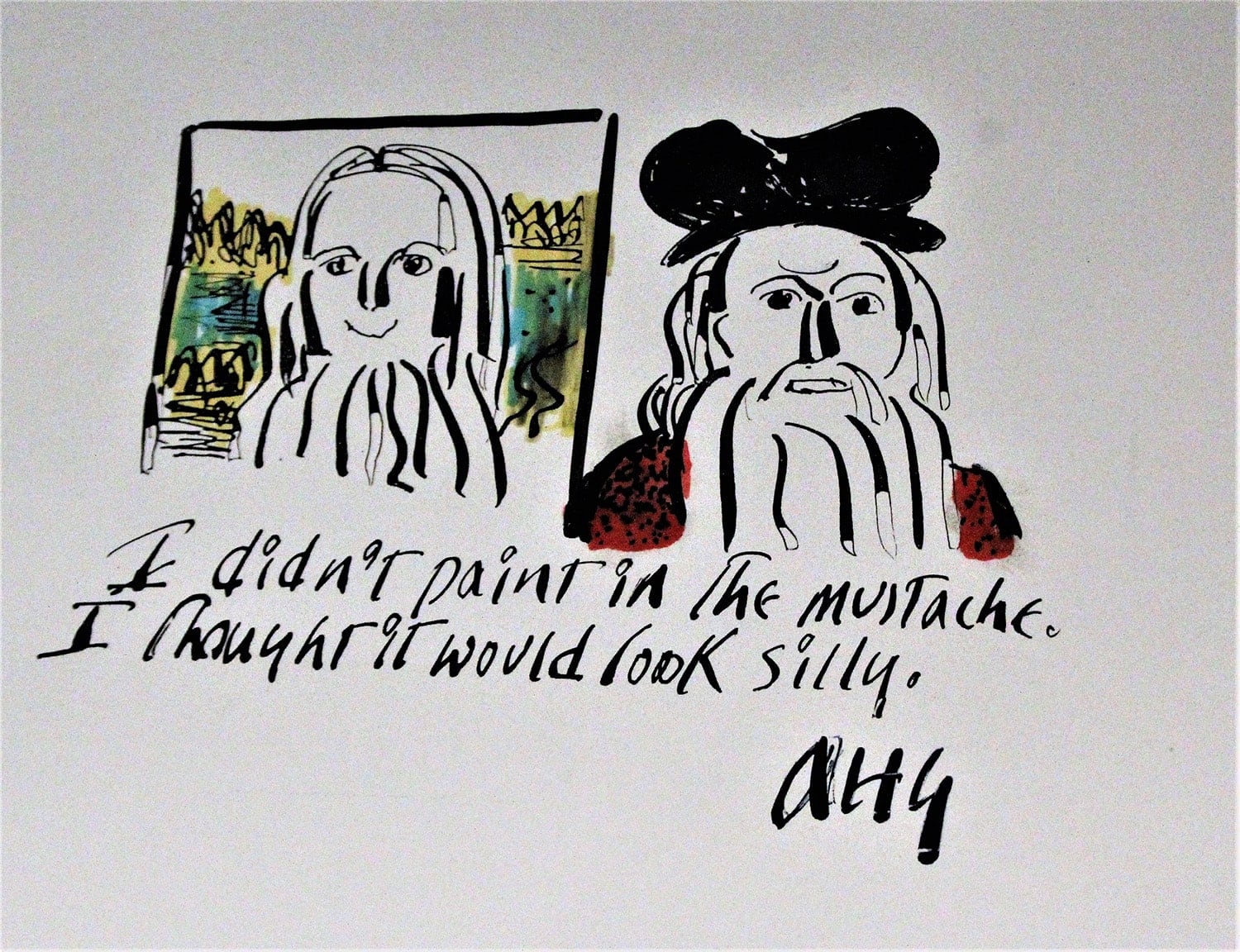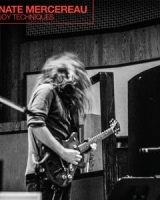Life of the art party

Scene from the gallery during Anthony Haden-Guest’s birthday party
I met Anthony Haden-Guest in Williamsburg at a party for a talented painter in a re-done loft. Anthony was dressed to the nines in a sport jacket, drinking champagne with a raspberry floating on top. Although nobody wants to consider themselves someone who gets star-struck, I found myself hoping I’d somehow impress him. Anthony’s a well-known art critic, writer and cartoonist. His book, True Colors, details the social circle of fine art and intimately describes the rise to fame of artists such as Keith Haring and Julian Schnabel. It’s rare to meet someone whose social experience has been around some of the most sought out people in the world. Because of this, I find myself wanting to know what it is about him that kept their interest.
I schedule an interview with Anthony for this article. He cancels our original date, remembering it falls on his 80th birthday. I wonder what world of art must be going through his head to forget such an important day. He tells me the name of the gallery and then says, “See you then,” before hanging up abruptly. I arrive at the Lower East Side gallery with artist Lisa Levy and another friend. After wine, art, (and cake of course), the entire party moves to a DIY boxing gym where we watch Anthony box a judge. The crowd cheers. After round one, someone dressed as Donald Trump enters the boxing ring to pay off the judge and then box Anthony. “This is really awesome,” Lisa Levy says to me. “He could have a really stuck up party if he wanted, like full of serious people, but he decided to do something cool.”
I look around me. She’s absolutely right. This is not the kind of party or crowd you’d expect for someone so accomplished.

The judge, left and Anthony Haden-Guest, right, in the ring right before his birthday party boxing match at Overthrow.
I finally meet with Anthony the next week. I’m almost done with True Colors and I have so many questions. Looking at his cartoons on the Observer I’m interested to know more about him as an artist. I ask at what point Anthony the cartoonist emerged. He tells me he’s been a slow developer. Everyone in the business knew at a young age what they wanted to do. He tried out drawing much later. He’s sure to specify that he doesn’t consider his work “fine art.” Despite this claim, there seems to be an elite effect in his work. His pen stays steady, and he’s developed a style which instantly recognizable–perhaps the hardest thing to do of all. Weeks later at Spring Break Art Show he showcases his cartoons. The booth is glowing with lighting fixtures he’s made that instantly draw you in. Once inside, the cartoons are scattered everywhere. It’s interactive. You can pick them up, take a closer look, or view them on the wall. Art fairs are notorious for needing, big, bright and attention-grabbing pieces in booths to catch people’s eyes when there’s so much to look at. Only someone who understood not only how to create art, but how it plays into its surroundings would have set it up this way. Still he insists although he began his cartoons as far back as his time at Cambridge, it’s only as of late that they’ve truly evolved. “They didn’t express my ideas very well then.”

One of Haden-Guest’s recent cartoons.
Thinking about his work before he was a cartoonist and how it may have influenced him, I ask just how he was able to infiltrate the lives of these famous artists. “Well,” he says, his legs crossed. His accent answers me in a factual tone. “I took an interest in them. Most artists are kind of needy. Who do they have to talk to? Other artists make them jealous. Galleries are looking for deals, so they can’t be trusted. I showed an interest.”
I then think of myself–which we all are seeming to be doing all the time and just goes to prove his point. I’m a writer. I’m also an artist. While reading True Colors where artists spend their whole life in one profession, I wonder about my generation. Today it seems like everyone is a photographer/musician/writer/PR person. Then I think again about Anthony–who was interdisciplinary before it was popular.
“How does that make you feel though? Your writing is both about all of these people who knew this their whole lives, and then you write these long form articles. What do you think about my generation, which, myself included, seems to be these jack of all trades, masters of none?” I expect him to have some large declaration about how art is dead, and nobody does anything good anymore, but instead he surprises me. “Well, things are constantly shifting. The way people create art is different, and so is the way people read. I recognize that.”
Man. I get it. I really do. I read 300 word articles all day. Even typing this I wonder who will have the patience or discipline to read the entire text without skimming. Are you still here with me?

Anthony Haden-Guest cartoons.
At the same time, intelligent writing seems so out of reach. I’m honest with him again, “I just came back from a writer’s conference, and it felt like a circle jerk. Poetry today seems so inaccessible. Why is that?”
Then he expands on his thoughts. “You know when I was your age, people in school in the arts, would be in a room and we’d be talking about music, we’d be talking about movies, but we wouldn’t be talking about art. That’s how I feel about poetry today.” To Anthony, this isn’t a good or bad thing. Just a change in the times. “If Browning were around today would he be writing poetry? Probably not. He’d be writing plays or films. With such talent why would you choose something so limited? Now it’s the opposite. You have people talking about art, and it’s a new form. It’s not quite design, not quite art. It’s fast. It’s visual, easy to understand.”
His comprehension of the times goes to show why he had such an exciting booth at Spring Break. How he knew to add lights and a hands-on experience without thinking about it at all.
The conversation pivots. “Something I noticed about your birthday party, and also you inviting me here–” I began to ask, but then I pause. This is awkward, but what kind of conversations do we learn from if no ground is broken? I go ahead and say it, “Like, I can’t do anything for you. At Large is a great publication, but it’s not like I’m able to actually help you or your career, and the same thing was with your party. It was original, which is actually way cooler than doing something stuffy. I guess what I’m getting at is, why would you do this? Why would you agree to this interview?”
“I like taking jobs that are like hack jobs.” He smiles.
I wonder how he seems at peace will all of these changes which have occurred so quickly. Why he, himself seems to still be evolving despite the fact that he’s made it already and developing new skills isn’t required of him at all. He tells me, “Something strange happens when you’re older, like in your 60s. You become a nuisance. Young people want your job. But when you go up fifteen years nobody wants it, because you became it.”
And that there is his answer to still being a force within art, and living in the moment. Take an interest, evolve, own it.

